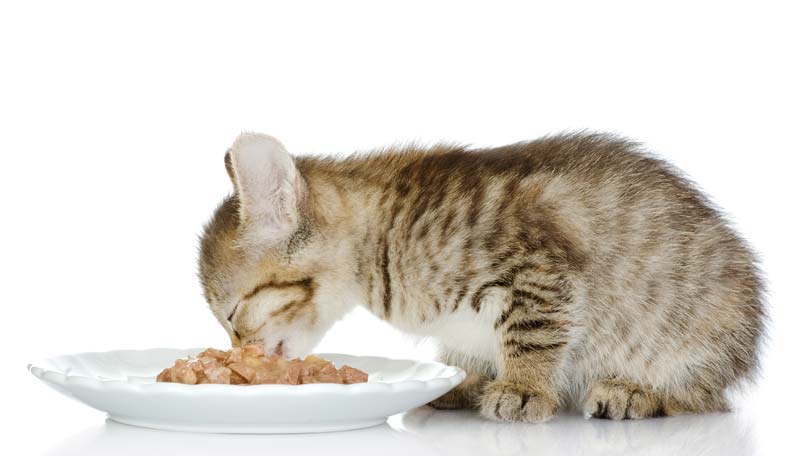
Cat food choices abound with fish, chicken, fresh flavors, hard crunch, chewy centers, and of course, wet mushy delectable bites. For a cat, their favorite is going to be anything that actually tastes like fish or chicken. You’re probably not going to stand in the aisle taste testing the samples. Although I have seen stranger things in the pet supply store. So start where it makes sense, the back of the bag. Whether you’re selecting wet or dry cat food, the firs place to start is the list of ingredients.
In their more natural environment, cats are carnivores. Left to their own devices that make incredible hunters with the stealth of a missile when they find their prey. This is what their bodies are made to thrive on. This is what keeps them healthy. Thus, in any cat food, the one thing you are looking for is meat. Not a meat by-product. A by-product is just that, a substandard filling material that may have come from meat, but isn’t meat. It’s like trimming all the fat off of a luscious piece of prime rib and serving only the fat to your family. Certainly not the healthiest meal you could give them, if they could even choke down all that undissolved gristle.
If you don’t see something familiar, that you would eat, at the very top of the list of ingredients, then pass up the food. You should see words like “chicken,” and “salmon” and “turkey” without any additional verbiage surrounding it. Something simple that you would put in your mouth. “Chicken by-product” isn’t going on my plate any time soon.
Wheat is not healthy for cats. Cats don’t graze. In fact, cats don’t get any nutritional value from wheat. It is just a cost effective filler that allows for more volume of cat food with a less expensive price tag for the company. They’ll still charge you $15 for a 5 pound bag.
So how does this help you solve the debate between serving your kitty wet or dry cat food? We have to look a little deeper into the natural behaviors and dietary needs of the feline companions to answer that. Just as they are stealth hunters, cats of any type are also very efficient and thorough eaters. Perhaps it is a bit unpleasant to think about, but cats really don’t waste much of their prey. The flesh of their prey can often serve not only to feed their hunger, but the natural fluid also helps to keep them hydrated. Soft cat food most closely resembles this. However, cats will eat the bones, or at least a good portion of them, before they consider their prey to be waste material. The crunchiness of the hard texture is very good for their teeth. While you should not give your cat chicken bones, despite the fact they would consider you the best human in the world if you did, you do need to pay attention to the ease which cats rely on their diet to keep them both nutritionally and hygienically sound.
Cats that live on primarily wet food are typically healthier in their protein consumption but offend their human counterparts with particularly foul breath. You should get their teeth cleaned regularly, but between cleanings, cats require natural ways of keeping their mouths healthier. Kittens especially use the hard crunch to help establish new teeth as their baby teeth disappear.
Cats that live primarily off of dry cat foods tend to have healthier mouths but are lacking nutritionally, even if the difference is marginal. If you are trying to offer your cat the healthiest food possible, you may want to consider blending both dry and wet cat food. This gives them the best of both worlds.
Of course, there are down sides to this. For starters, cats generally don’t eat all of their food at one sitting. They are more nibblers by nature. Some will, but they are the rare sort. Leaving wet cat food at their disposal is not only an attraction for germs, but bugs and rodents as well.
One of the most convenient aspects of owning a cat is that a simple weekend away doesn’t entail the same hardships as it does with dogs. There is no need to find a cat sitter or to take them to a cat kennel. You have the option of leaving extra food down and disappearing for a couple of days. Having to contend with wet cat food, even a mixture of wet and dry, makes this sort of thing more difficult.
Ultimately, the choice made not be made by you, especially if you have adopted an older cat that is stubborn about keeping their diet the same. A test of wills can be difficult to endure when switching a cat’s food to something new, even when you try to adjust them slowly. The upset stomach, the constant mewling, and of course the beady eyed glare you receive as he waits for his usual food might be more than you can bear, even if it is for his own good. It often takes several tried to switch a cat from one food to the other.
When choosing your cat’s food, the ingredients and the nutritional levels are more important than whether you choose between wet or dry cat food. If your lifestyle can handle it, a mix is always preferable. Most cat owners who travel even just a bit opt for dry. The most important factor is that your cat is offered food that is nutritionally sound to allow him to live a full and healthy life.
